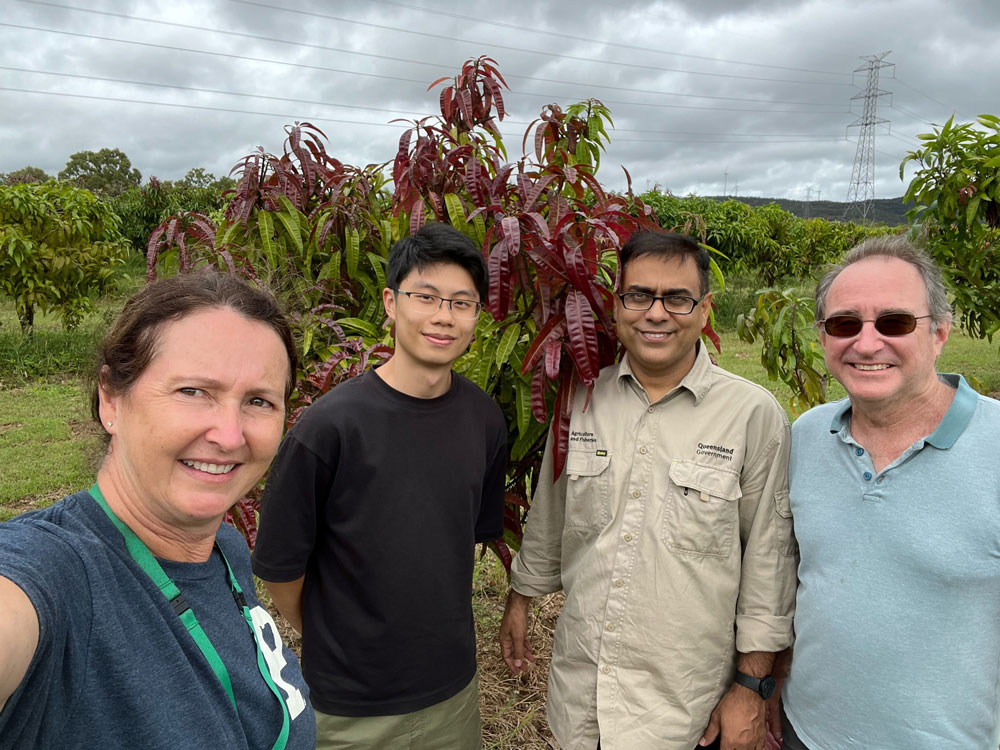We all know that as mangoes ripen, they get more yellow, or even orange. This is a similar phenomenon for most, if not all, mangoes. But why does the flesh of some mango varieties only reach a pale lemon colour, while others produce a dark orange that would not be astray in a ripe pumpkin?
University of Queensland student, Tatsu Takagi, is currently investigating this question as part of his PhD with Associate Professor Tim O’Hare at the Queensland Alliance for Agriculture and Food Innovation, in conjunction with the Department of Agriculture and Fisheries (DAF Queensland). Understanding the mechanism behind mango flesh colour is the first step in the development of breeding tools to enable our mango breeders to design tailor-made mangoes specifically suited to target markets in Australia and overseas. Not surprisingly, not everyone in the world likes the same colour. In cooperation with DAF scientists, Dr Natalie Dillon and Dr Asjad Ali, Tatsu has been able to access one of the most diverse mango collections in the world, located at Walkamin Research Facility on the Atherton Tableland. This collection includes mango varieties ranging from a pale lemon to a deep orange flesh colour when fully ripe.
Why are some mangoes pale lemon while others are dark orange?
The pigments that give all mango fruit their vivid yellow and orange flesh colours are known as carotenoids. Although there are hundreds of carotenoids that vary in colour from yellow to orange to red to salmon, the principal carotenoid in mangoes is betacarotene. Beta-carotene is also known as pro-Vitamin A, because when eaten it is converted to retinol (Vitamin A), which amongst other health benefits, is known for its association with improving night vision. So, why are some mangoes pale lemon while others are dark orange? There are a number of potential reasons. In a study of 26 differently coloured varieties, the palest lemon varieties tended to have the lowest concentration of carotenoid pigments, whilst the more orange varieties tended to have a higher concentration.
However, it appears to be more complicated than this. When we think of colour, we tend to think of it like the colours of the rainbow. But, colour is a combination of two factors - its hue (yellow through to orange) and the intensity of that hue (pale orange through to dark orange). Consequently, what we are observing is a complex matrix of flesh hues across varieties that also range in colour intensity.
Mango varieties and their flesh colour
At one extreme, we have a mango variety like ‘Himayat Pasand’ which is pale yellow, while at the other extreme we have a variety like ‘Willard’, which is dark orange. In between, we have a more familiar variety such as ‘Calypso®’, which is a mid-range orange-yellow colour. In the image below, we can see the range of flesh colour starting with the pale yellow ‘Himayat Pasand’ on the left, all the way to the deep orange ‘Willard’ variety on the very right. The other varieties shown in between are ‘Nam Doc Mai’, ‘Xoài Boui’ and ‘Oh’Ure Pio’, from left to right, respectively. Interestingly, as mango varieties increase in their ‘orangeness’, the variability of the colour intensity also seems to increase. Consequently, a variety such as ‘Carrie’ can be the same orange hue as the variety ‘Julie’ and ‘Kimba’, but each of these varieties varies greatly in the intensity of this orange colour.

Identifying the cause of variation in mango flesh colour
Trying to understand what causes the variation in both their hue and intensity of flesh colour is the challenge. A first step to solving this is to analyse the carotenoid profiles of all these varieties, including what carotenoid pigments are present, and how much of each pigment. This requires ripening all the fruit to the same ripeness, and then carefully extracting the carotenoids, before identifying and quantifying the individual carotenoids using highperformance liquid chromatography. Working together with UQ analytical chemist, Dr Hung Hong, Tatsu has optimised this methodology for mangoes.
Once this step is completed, the next step is to identify how this complicated profile of carotenoid pigments is related to both the flesh hue, and to the intensity of this hue. In this way, it is hoped we can develop an insight as to what combination of pigments is required to attain a dark orange mango flesh or a pale lemon flesh, or somewhere in between.
Genes and flesh colour
Just knowing what profile of carotenoid pigments leads to a certain colour unfortunately does not provide a tool to developing tailor-made mango fleshcolour. Breeders also need to be able to control the mix of carotenoids that are present.
The amount of each carotenoid pigment ending up in a ripe mango is fundamentally controlled by its DNA. Small changes in the genetic code of genes making up the DNA can have significant impact on flesh colour. Numerous genes are responsible for producing enzymes, which in turn are responsible for determining how much of a particular carotenoid pigment is present in the fruit, and consequently its colour. Finding out which genes are the important ones is the next challenge.

There are a couple of ways to work out which are the important genes, and Tatsu will be using a number of approaches. Firstly, simply looking at the carotenoid profile of an individual mango variety gives us an educated clue as to what genes are important, particularly within the biosynthesis pathway in which these pigments are made. These are ‘candidate’ genes, which can increase total carotenoid production or just modify the level of a particular carotenoid pigment.
An additional approach, called ‘GWAS’, or ‘Genome-wide association study’, is another way to find the important genes controlling flesh colour. This requires the sequencing of the DNA genomes of hundreds of mango varieties, and then matching them with their ripe fruit colour. Fortunately, the genome sequencing has already been completed within another UQ/ DAF project, so the next step is to use this data. This approach will confirm if the candidate genes have a significant effect on flesh colour, but also is likely to identify unrelated genes that may indirectly affect mango flesh colour.
Breeding for flesh colour
As a new mango cultivar takes years to breed, it would be ideal to have genetic markers for breeders to use to identify seedlings with a targeted flesh colour. A newly bred mango plant can take decades to develop and can require considerable resources raising thousands of seedlings to fruiting stage. And using this method, the flesh colour, amongst other traits, is a gamble. It is hoped that Tatsu’s PhD study will help us understand how to manipulate flesh colour in future generations of mangoes.
Acknowledgement
Tatsu’s PhD study is part of a joint UQ/DAF Hort Innovation Frontiers project ‘Genetics of Fruit Sensory Preferences’. This project was funded by Hort Innovation as part of the Hort Frontiers strategic partnership initiative, with co-investment from Queensland Department of Agriculture and Fisheries and contributions from the Australian Government.
This article was first published in Mango Matters April 2023 edition.

